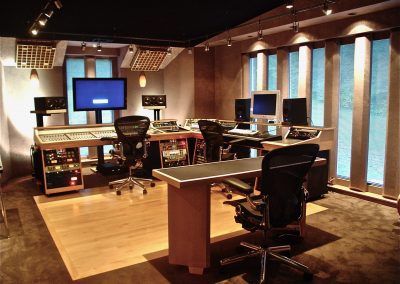By Frank Wells Prosound News, Oct. 2006
NASHVILLE, TN – The personal production studio has come of age, and “the Grip,” the personal space created for songwriter, producer (Chicago XXX, most recently) and bass player for country stalwarts Rascal Flatts, Jay DeMarcus, is case in point. Built into DeMarcus’ spacious home just south of Nashville’s upscale Green Hills district, The Grip marries the feature set of a high-end commercial facility with the personal vision and work preference of the owner.
Carl Tatz, principal in Carl Tatz Design (CTD), oversaw the 8-month renovation of the space, interpreting and accommodating DeMarcus’ desires into the finished product.
DeMarcus’ vision included an open feel-The Grip has ample natural lighting with a window to the outside in front of the Digidesign Pro Control anchored control room and windows along the right side, the glass paraleled on the left of the engineer’s position looking into the studio. Among Acoustic treatment elements that include 23 Hz axial-mode absorbers at room rear, Tatz employed removable custom ASC vertical traps along the side floor-to-ceiling windows, the traps spaced to allow visibility. “It’s a great way to have glass,” says Tatz, “but still control reflections.”
A Sound Construction desk houses the Pro Control, driving an expanded Apple G5-based Pro Tools|HD rig (housed in a machine closet with access to the front of the rig from the studio and to the rear and wiring from a hallway). To maintain ties to a classic analog sound, a Neve 8816, Demeter, Crane Song, Apogee, TubeTech and AMEK. Audio One’s Jason Finley, product manager for The Grip, says that Audio One believes that preamp selection is a critical component of modern recording, singling out Vintech’s 1073 modules: “The Vintech pre’s give him the warm and fat sounds of the days past, without the worry, maintenance and hassle of vintage gear. Being in the room as we dialed up the very first drum sounds, it was clear that big drum sounds weren’t going to be a problem.” A HearBack cue system from Hear Technologies bridges the control room to studio. MIDI links and DAW control extensions abound.
The Tatz-designed and -implemented monitor system is built around a pair of Dynaudio Acoustic M1s on rigidized stands and driven by Bryston’s 4BST amp. The Dynaudio BM12s active subs are hidden behind grill cloth below the M1s, mounted on rigid slabs and facing the wall. Tatz painstakingly tuned the monitor system using CTD’s proprietary PhantomFocus approach, which involves use of SMAART acoustic analysis, Meyer and Ashly EQs and an NHT crossover (the latter he calls his “secret weapon,” as it allows 360 degrees of phase control). “I’m giving them God,” says Tatz of the tightly focused sweet spot, adding that he’s “pushing 20 Hz” in the room. Tatz says there’s also a “secondary” sweet spot at the removable producer’s desk midway back in the control room. A keayboard/composing station on the right side of the control room offers Tannoy Reveals for monitoring.
The drum area in the main studio uses PartScience SpaceArray blocks alternating with low-end control panels on one wall, facing low-end diffusion panels on the other wall. More PartScience panels sit above the drum pad, coupling to the space above. Two booths flank the front of the studio space, one with a window to the outside, the other with a step up to a third smaller booth/amp room. The studio uses floating floors and custom thermopane glass in what Tatz calls “meat and potatoes” acoustic approaches. The climate control units for the house and studio were raised on isloators, and roofed over for sound control. Entrance to The Grip is through the home’s garage, allowing commercial session work for a “select” clientele. The garage also has a Leslie room tied to the studio.
Through a well-complemented lounge with a modern loft feel is The Cockpit, a secondary editing and production station based around Digidesign’s 002 controller and Pro Tools, with a second CTD PhantomFocus System™, this time using Dynaudio BM6A monitors and NHT subs. The BM6As are soffit-mounted and sitting on granite while the subs are damped by top and bottom sand boxes. The work area is inside a shell of CTD’s custom diffusors.
Audio One’s John Castellanos, who was the lead consultant on the install concludes, “We migrated Jay from a decent home recording studio in one house, to a full-on, no-holds-barred, Class-A recording facility.” DeMarcus can just grip the well-worn Fender Jazz bass neck that serves as a door handle and step into his vision.

















